
Summer is drawing to a close. If you made it to the beach this year, you managed to get your tan on and survive a shark attack. Congratulations! But there is another swimming danger that you should be aware of and that is moving into its most dangerous season: the riptide.
Riptides (properly called rip currents as they’re not actually a tide), are long, narrow channels of water which move from shore to sea and can take you with them as they go. They’re much more common during hurricane season, and especially the peak of hurricane season which is August until October.
80% of all open water rescue attempts are due to riptides, and they claim over 100 victims a year. So here’s a primer on what a rip current is, how to spot one, and how to survive if you get picked up and taken for a ride.
What Is a Rip Current?
Rip currents are channels of water which flow away from the shore and out to sea. As waves come into the shore, water piles up and needs somewhere to go. Instead of returning over the reef or sandbar from which it came, the current may take the path of least resistance and be funneled into a channel between two obstacles. Here’s a handy diagram and a more technical explanation from the NOAA:
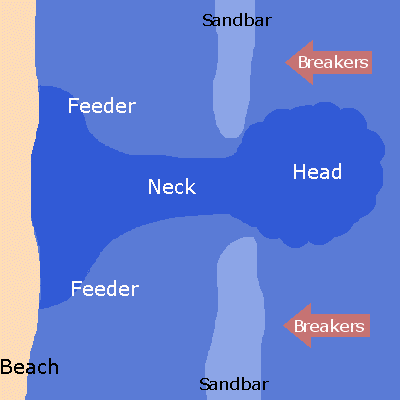
- Waves break on the sand bars before they break in the channel area.
- Wave breaking causes an increase in water level over the bars relative to the channel level.
- A pressure gradient is created due to the higher water level over the bars.
- This pressure gradient drives a current alongshore (the feeder current).
- The longshore currents converge and turn seaward, flowing through the low area or channel between the sand bars.
There are three kinds of rips:
Flash rip: A rip current can form suddenly and vanish just as fast due to decreasing water levels or increasing wave heights.
Fixed rip: A fixed rip, sometimes formed between sand bars, can stay in the same place for days, weeks, or even months.
Permanent Rip: In a place with a permanent obstacle like a reef, a rip may be ever present.
How to Spot a Rip Current
Riptides can occur anywhere there are breaking waves, including large lakes. Spotting a rip current is not always easy, especially to the untrained eye. So be sure to heed warnings that are posted and issued by lifeguards and the like.
Here are some things to look for along with pictures from the University of Delaware:
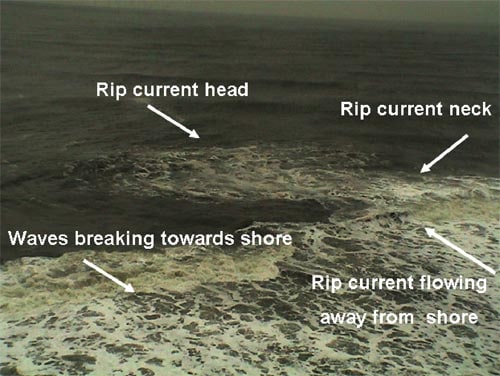
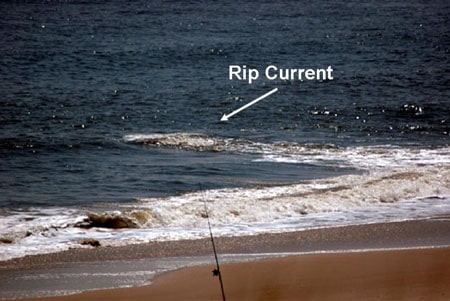 A channel of churning, foaming, or choppy water
A channel of churning, foaming, or choppy water
 A rip current will pick up things like seaweed, forming a debris conga line which moves steadily seaward
A rip current will pick up things like seaweed, forming a debris conga line which moves steadily seaward
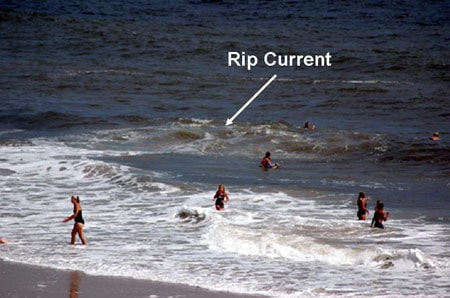 In addition to debris, the rip current picks and stirs up sand, so look for areas of the water that are a different color than the surrounding water
In addition to debris, the rip current picks and stirs up sand, so look for areas of the water that are a different color than the surrounding water
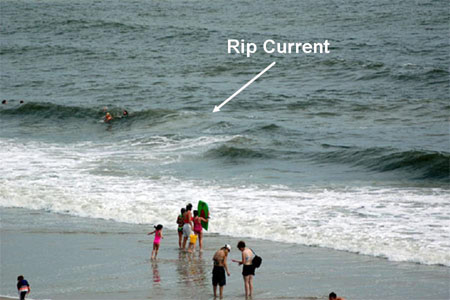 A break in the incoming wave pattern
A break in the incoming wave pattern
How to Escape a Rip Current
As mentioned, a rip current can suddenly appear. They can also rapidly ramp up in velocity. A rip current moving at 1-2 feet per second is no cause for alarm. But it can quickly start to move at a more dangerous 3 feet per second and have even been clocked trucking along at 8 feet per second.
If you get caught in a riptide, here’s what to do:
Don’t panic. Feeling like you’re getting swept out to sea can be terrifying. But try to keep calm. Rip currents won’t pull you under — they’re just channels of moving water. And while they can extend a ways out, they do eventually dissipate, most within 50-100 feet of the shoreline. So you’re not going to wash up on the shores of a deserted island with only a volleyball for a friend.
Don’t try to swim against the rip. Deaths that result from riptides aren’t caused by the current pulling someone under; instead, the person typically panics, starts trying to swim against the rip to get back to shore, becomes exhausted, and drowns. An 8-feet-per-second riptide is so strong that not even Michael Phelps could swim against it. Don’t kick against the pricks.
Swim parallel to the shore. Instead of swimming against the rip current, you want to swim perpendicular to it, in either direction. Rip currents are typically only 20-100 feet wide. Once you leave the rip, swim at an angle away from it towards the shore.
Go with the flow. If you don’t have the swimming skills or energy to swim out of the rip, float on your back and go with the current. Just imagine you’re taking a spin on the Lazy River at the water park you went to as a kid. Once the rip current dissipates, you can do the parallel swim thing or try to signal to the lifeguard or someone else that you’re in need of help.







